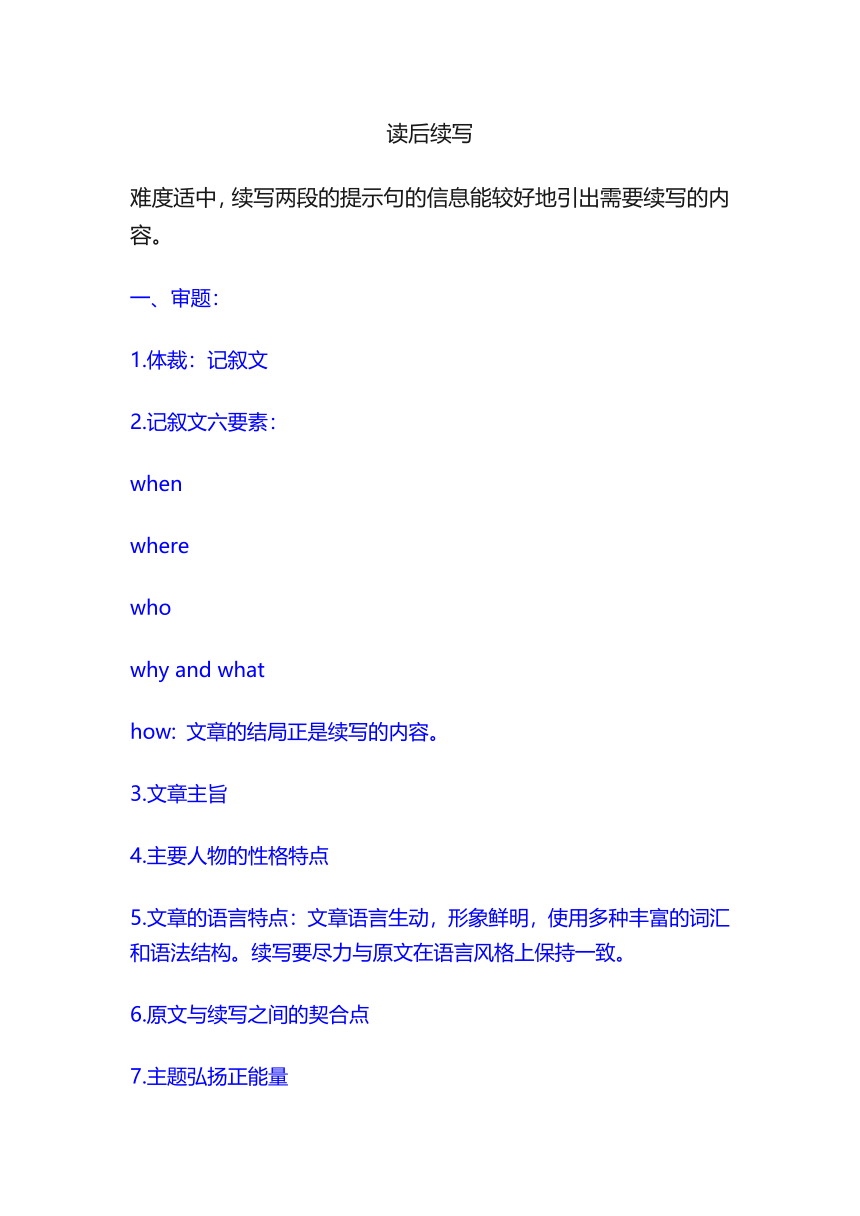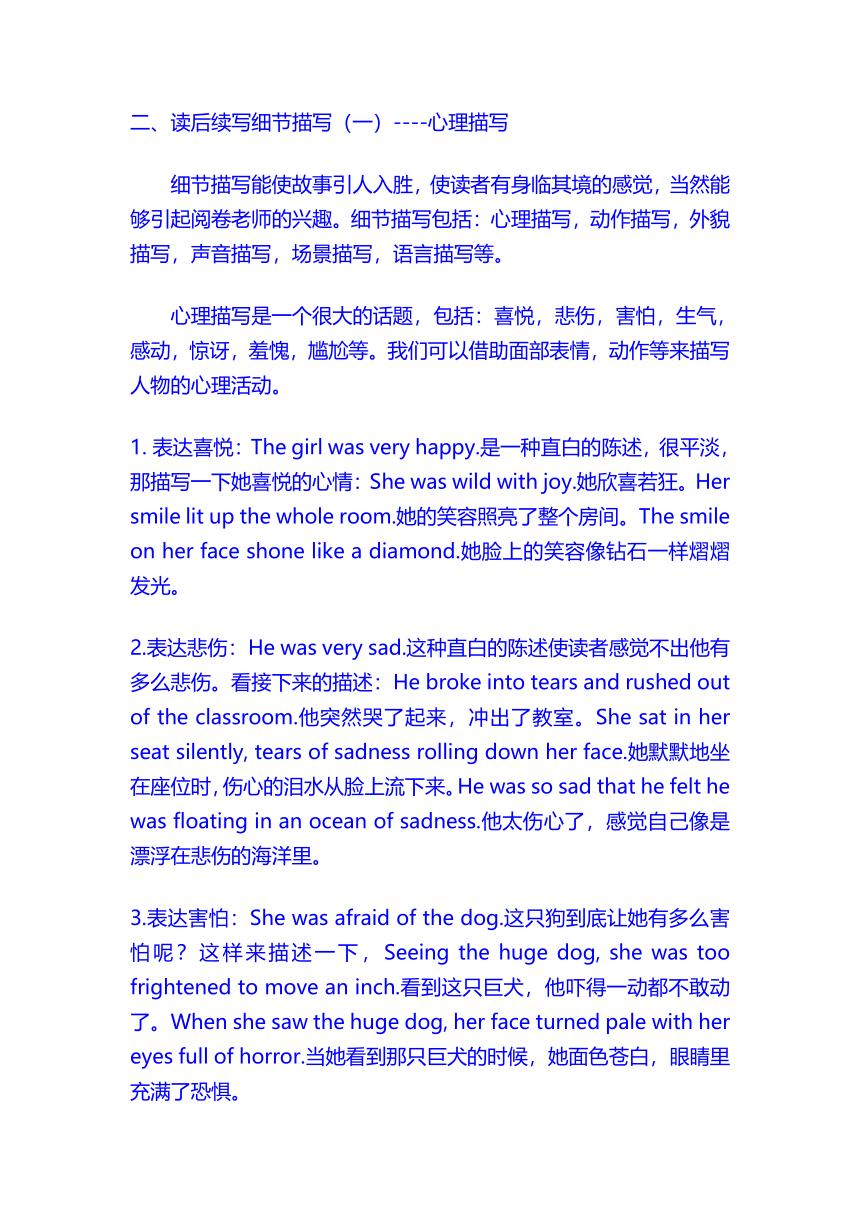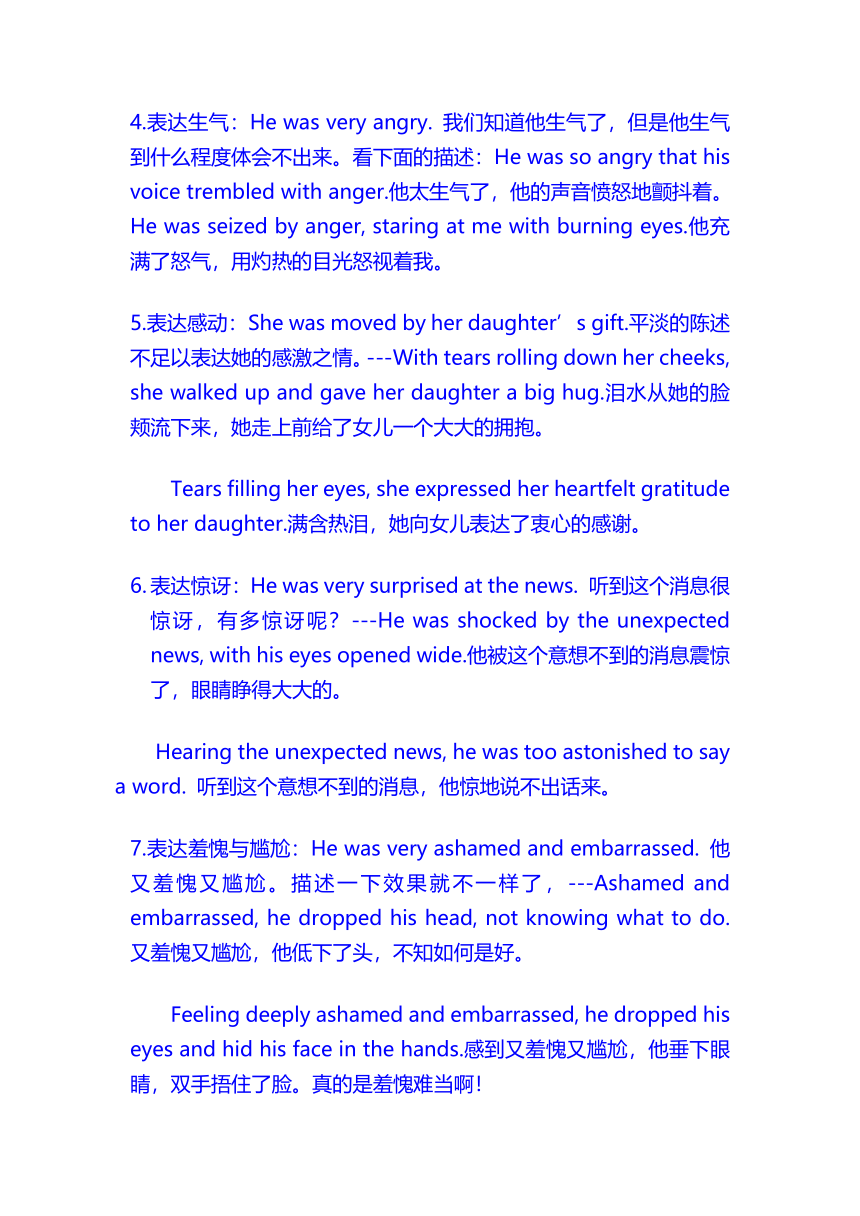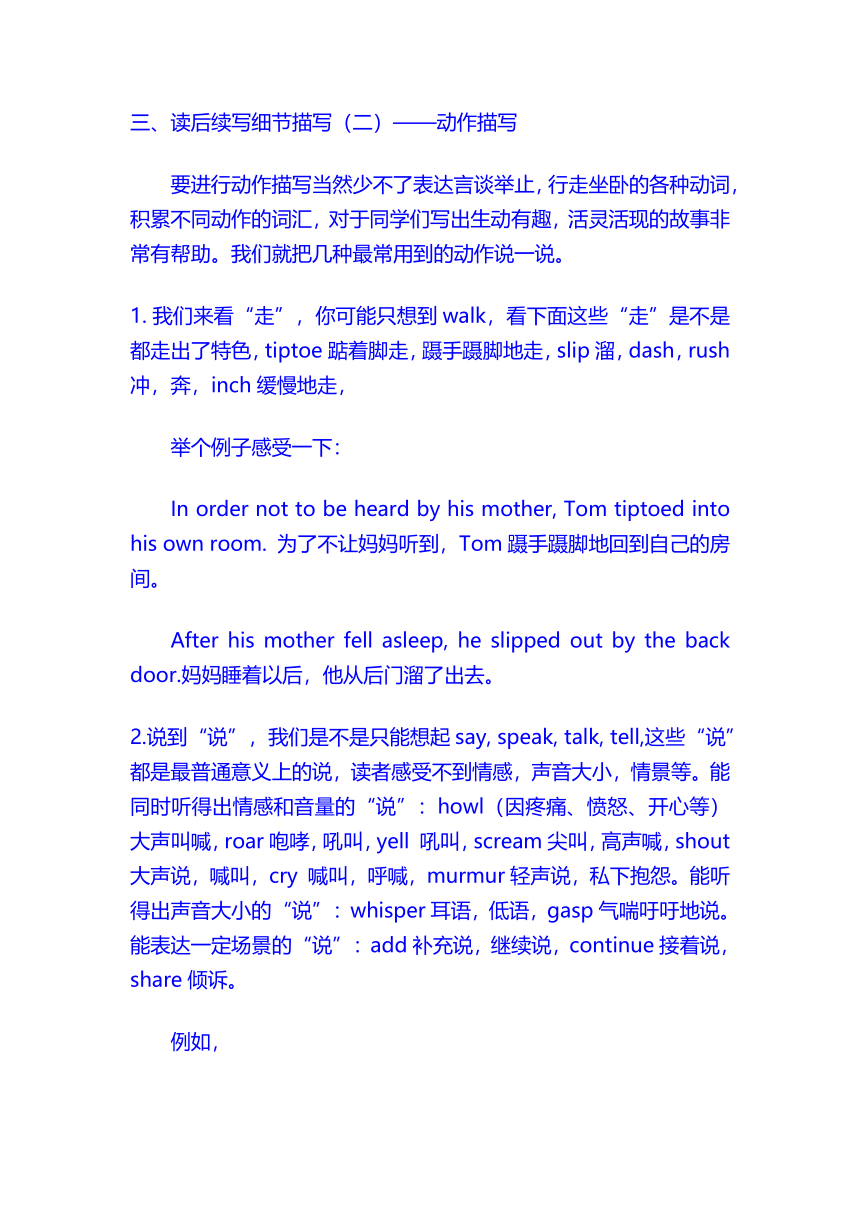2023届高考英语读后续写做题技巧讲义
文档属性
| 名称 | 2023届高考英语读后续写做题技巧讲义 |  | |
| 格式 | docx | ||
| 文件大小 | 19.1KB | ||
| 资源类型 | 教案 | ||
| 版本资源 | 通用版 | ||
| 科目 | 英语 | ||
| 更新时间 | 2022-12-09 08:43:07 | ||
图片预览




文档简介
读后续写
难度适中,续写两段的提示句的信息能较好地引出需要续写的内容。
一、审题:
1.体裁:记叙文
2.记叙文六要素:
when
where
who
why and what
how: 文章的结局正是续写的内容。
3.文章主旨
4.主要人物的性格特点
5.文章的语言特点:文章语言生动,形象鲜明,使用多种丰富的词汇和语法结构。续写要尽力与原文在语言风格上保持一致。
6.原文与续写之间的契合点
7.主题弘扬正能量
二、读后续写细节描写(一)----心理描写
细节描写能使故事引人入胜,使读者有身临其境的感觉,当然能够引起阅卷老师的兴趣。细节描写包括:心理描写,动作描写,外貌描写,声音描写,场景描写,语言描写等。
心理描写是一个很大的话题,包括:喜悦,悲伤,害怕,生气,感动,惊讶,羞愧,尴尬等。我们可以借助面部表情,动作等来描写人物的心理活动。
表达喜悦:The girl was very happy.是一种直白的陈述,很平淡,那描写一下她喜悦的心情:She was wild with joy.她欣喜若狂。Her smile lit up the whole room.她的笑容照亮了整个房间。The smile on her face shone like a diamond.她脸上的笑容像钻石一样熠熠发光。
2.表达悲伤:He was very sad.这种直白的陈述使读者感觉不出他有多么悲伤。看接下来的描述:He broke into tears and rushed out of the classroom.他突然哭了起来,冲出了教室。She sat in her seat silently, tears of sadness rolling down her face.她默默地坐在座位时,伤心的泪水从脸上流下来。He was so sad that he felt he was floating in an ocean of sadness.他太伤心了,感觉自己像是漂浮在悲伤的海洋里。
3.表达害怕:She was afraid of the dog.这只狗到底让她有多么害怕呢?这样来描述一下,Seeing the huge dog, she was too frightened to move an inch.看到这只巨犬,他吓得一动都不敢动了。When she saw the huge dog, her face turned pale with her eyes full of horror.当她看到那只巨犬的时候,她面色苍白,眼睛里充满了恐惧。
4.表达生气:He was very angry. 我们知道他生气了,但是他生气到什么程度体会不出来。看下面的描述:He was so angry that his voice trembled with anger.他太生气了,他的声音愤怒地颤抖着。He was seized by anger, staring at me with burning eyes.他充满了怒气,用灼热的目光怒视着我。
5.表达感动:She was moved by her daughter’s gift.平淡的陈述不足以表达她的感激之情。---With tears rolling down her cheeks, she walked up and gave her daughter a big hug.泪水从她的脸颊流下来,她走上前给了女儿一个大大的拥抱。
Tears filling her eyes, she expressed her heartfelt gratitude to her daughter.满含热泪,她向女儿表达了衷心的感谢。
表达惊讶:He was very surprised at the news. 听到这个消息很惊讶,有多惊讶呢?---He was shocked by the unexpected news, with his eyes opened wide.他被这个意想不到的消息震惊了,眼睛睁得大大的。
Hearing the unexpected news, he was too astonished to say a word. 听到这个意想不到的消息,他惊地说不出话来。
7.表达羞愧与尴尬:He was very ashamed and embarrassed. 他又羞愧又尴尬。描述一下效果就不一样了,---Ashamed and embarrassed, he dropped his head, not knowing what to do.又羞愧又尴尬,他低下了头,不知如何是好。
Feeling deeply ashamed and embarrassed, he dropped his eyes and hid his face in the hands.感到又羞愧又尴尬,他垂下眼睛,双手捂住了脸。真的是羞愧难当啊!
三、读后续写细节描写(二)——动作描写
要进行动作描写当然少不了表达言谈举止,行走坐卧的各种动词,积累不同动作的词汇,对于同学们写出生动有趣,活灵活现的故事非常有帮助。我们就把几种最常用到的动作说一说。
我们来看“走”,你可能只想到walk,看下面这些“走”是不是都走出了特色,tiptoe踮着脚走,蹑手蹑脚地走,slip溜,dash,rush冲,奔,inch缓慢地走,
举个例子感受一下:
In order not to be heard by his mother, Tom tiptoed into his own room. 为了不让妈妈听到,Tom蹑手蹑脚地回到自己的房间。
After his mother fell asleep, he slipped out by the back door.妈妈睡着以后,他从后门溜了出去。
2.说到“说”,我们是不是只能想起say, speak, talk, tell,这些“说”都是最普通意义上的说,读者感受不到情感,声音大小,情景等。能同时听得出情感和音量的“说”:howl(因疼痛、愤怒、开心等)大声叫喊,roar咆哮,吼叫,yell 吼叫,scream尖叫,高声喊,shout 大声说,喊叫,cry 喊叫,呼喊,murmur轻声说,私下抱怨。能听得出声音大小的“说”:whisper耳语,低语,gasp气喘吁吁地说。能表达一定场景的“说”:add补充说,继续说,continue接着说,share倾诉。
例如,
The children were screaming excitedly in the classroom. 孩子们在教室里兴奋地喊叫着。
The kid howled his dissatisfaction. 孩子不满地怒吼着。
“I’m delighted that I was able to bring my grandma the happy experience.”she shared. 她倾诉到,“我很高兴能祖母带来了愉快的经历。”
再来说一说“看”,你是不是只能想到look at, see, 看也分不同的看呀,glare at怒目而视,stare at,gaze at凝视,盯着看 peep at偷窥 glance at浏览,瞥一眼。
体会一下不同的“看”带给你的不同感受,
例如,The wolf didn’t move, glaring at me silently.狼没有动,只是默默地怒视着我。
He tiptoed to the door, and peeped at what was happening in the room.他蹑手蹑脚地走到门口,偷看屋里正在发生什么事。
用不同的方式表达“笑”:laugh大笑,出声的笑, smile微笑,是最常用的词汇,看看下面句子中都是怎么笑的吧!
Receiving the beautiful gift, the little girl was beaming with pleasure.收到精美的礼物,小女孩眉开眼笑。
The whole class giggled at the funny joke told by Tom. 全班同学都被汤姆讲的笑话逗得咯咯地笑起来。
哭也有不同声音和不同情感的哭!不能单纯的使用cry来表示哭了,cry表示大声且流泪的哭,看看下面的例句感受一下不同的哭,
Walking into the room to see him looking so sick, I couldn’t help weeping.走进房间看到他病恹恹的样子,我禁不住哭了起来。weep往往表示因伤心而小声流泪的哭泣。
My son suddenly choked with sobs, his tears rushing violently from his eyes.我的儿子突然哽咽起来,泪水夺眶而出。
四、读后续写细节描写(三)——高级句式的运用
要更好地达到故事生动有趣,画面感强的效果,还必须通过高级句式表达出来。
—ing形式做状语。它的语法功能是:-ing形式做状语表示动作与谓语动词动作同时发生,并且与句子主语之间是主动关系。从其语法功能就可以看出前后动作的连贯性,可以很好地表达出故事人物的生动形象。
例如,Hearing the news, he burst into laughter. 听到这个消息,他突然大笑起来。Seeing the teacher entering the classroom, the girl blushed with shame. 看到老师走进教室,女孩羞愧得脸红了。
2.so+adj/adv+that太…以至于,引导结果状语从句,这个句型可以用来表达主语所处的身体或心理的状态以及所造成的结果,有非常强的表达效果。
例如,She was so scared at the snake that her face turned pale and didn’t dare to move an inch. 她被蛇吓得脸色苍白,一动也不敢动。
这个句型还非常适合用倒装句,so+adj/adv位于句首,句子部分倒装,把助动词,情态动词或be动词提前。还是刚才那个例子,可以改写成:So scared was she at the snake that her face turned pale and didn’t dare to move an inch. 这样表达更高级,更有表现力,更能体现考生的语言表达能力。
形容词作状语。形容词作状语往往表达主语的性质或主语所处的身体或心理状态,非常适合进行心理描写。
例如,
Embarrassed and ashamed, I can’t concentrate on anything. 又尴尬又羞愧,我无法集中精力做任何事情。
Moved and excited, she threw herself into her mother’s arms. 她又感动又激动,扑进了母亲的怀抱。
两个或三个并列动词做谓语。接连的动作可以很好得进行动作描写,使动作连贯,紧凑,有画面感。
例如,He rushed into the burning house, picked up the crying child and flew out into the yard. 他冲进着火的房子,抱起哭泣的孩子,飞奔到院子里。
强调句:It+is/was+被强调的部分+that/who从句 这个句型非常适合在读后续写的结尾进行情感的升华。
例如,
It was Mr Smith’s kindness that helped my family got over the difficulties. 正是史密斯先生的善良帮助我们家度过了难关。
It was his attitude towards life that made a positive difference to the community. 正是他对生活的态度对社区产生了积极的影响。
6.高级句式的结合使用,能使你的文字更有表现力,更能体现考生的语言驾驭能力,运用适当的话可以为你的作文得高分保驾护航。
例如,Seeing the snake, the girl was so frightened that her face turned pale and didn’t dare to move an inch. 看到蛇,女孩吓得脸色苍白,一动也不敢动。这是-ing形式做状语与so+adj+that从句的结合。
再例如,Learning the emergency, he rushed into the burning house, pickedup the crying child and flew out into the yard. 得知情况紧急,他冲进着火的房子,抱起哭泣的孩子,飞奔到院子里。这是ing形式做状语与并列谓语的结合。
再例如,He was so embarrassed that he walked back to his seat, droppedhis head and covered his face in his hands. 他尴尬得走回座位,低下头,用双手捂住脸。这是so…that 句型与并列谓语动词的结合。
好的句式要经过反复练习,努力用对用恰当。
难度适中,续写两段的提示句的信息能较好地引出需要续写的内容。
一、审题:
1.体裁:记叙文
2.记叙文六要素:
when
where
who
why and what
how: 文章的结局正是续写的内容。
3.文章主旨
4.主要人物的性格特点
5.文章的语言特点:文章语言生动,形象鲜明,使用多种丰富的词汇和语法结构。续写要尽力与原文在语言风格上保持一致。
6.原文与续写之间的契合点
7.主题弘扬正能量
二、读后续写细节描写(一)----心理描写
细节描写能使故事引人入胜,使读者有身临其境的感觉,当然能够引起阅卷老师的兴趣。细节描写包括:心理描写,动作描写,外貌描写,声音描写,场景描写,语言描写等。
心理描写是一个很大的话题,包括:喜悦,悲伤,害怕,生气,感动,惊讶,羞愧,尴尬等。我们可以借助面部表情,动作等来描写人物的心理活动。
表达喜悦:The girl was very happy.是一种直白的陈述,很平淡,那描写一下她喜悦的心情:She was wild with joy.她欣喜若狂。Her smile lit up the whole room.她的笑容照亮了整个房间。The smile on her face shone like a diamond.她脸上的笑容像钻石一样熠熠发光。
2.表达悲伤:He was very sad.这种直白的陈述使读者感觉不出他有多么悲伤。看接下来的描述:He broke into tears and rushed out of the classroom.他突然哭了起来,冲出了教室。She sat in her seat silently, tears of sadness rolling down her face.她默默地坐在座位时,伤心的泪水从脸上流下来。He was so sad that he felt he was floating in an ocean of sadness.他太伤心了,感觉自己像是漂浮在悲伤的海洋里。
3.表达害怕:She was afraid of the dog.这只狗到底让她有多么害怕呢?这样来描述一下,Seeing the huge dog, she was too frightened to move an inch.看到这只巨犬,他吓得一动都不敢动了。When she saw the huge dog, her face turned pale with her eyes full of horror.当她看到那只巨犬的时候,她面色苍白,眼睛里充满了恐惧。
4.表达生气:He was very angry. 我们知道他生气了,但是他生气到什么程度体会不出来。看下面的描述:He was so angry that his voice trembled with anger.他太生气了,他的声音愤怒地颤抖着。He was seized by anger, staring at me with burning eyes.他充满了怒气,用灼热的目光怒视着我。
5.表达感动:She was moved by her daughter’s gift.平淡的陈述不足以表达她的感激之情。---With tears rolling down her cheeks, she walked up and gave her daughter a big hug.泪水从她的脸颊流下来,她走上前给了女儿一个大大的拥抱。
Tears filling her eyes, she expressed her heartfelt gratitude to her daughter.满含热泪,她向女儿表达了衷心的感谢。
表达惊讶:He was very surprised at the news. 听到这个消息很惊讶,有多惊讶呢?---He was shocked by the unexpected news, with his eyes opened wide.他被这个意想不到的消息震惊了,眼睛睁得大大的。
Hearing the unexpected news, he was too astonished to say a word. 听到这个意想不到的消息,他惊地说不出话来。
7.表达羞愧与尴尬:He was very ashamed and embarrassed. 他又羞愧又尴尬。描述一下效果就不一样了,---Ashamed and embarrassed, he dropped his head, not knowing what to do.又羞愧又尴尬,他低下了头,不知如何是好。
Feeling deeply ashamed and embarrassed, he dropped his eyes and hid his face in the hands.感到又羞愧又尴尬,他垂下眼睛,双手捂住了脸。真的是羞愧难当啊!
三、读后续写细节描写(二)——动作描写
要进行动作描写当然少不了表达言谈举止,行走坐卧的各种动词,积累不同动作的词汇,对于同学们写出生动有趣,活灵活现的故事非常有帮助。我们就把几种最常用到的动作说一说。
我们来看“走”,你可能只想到walk,看下面这些“走”是不是都走出了特色,tiptoe踮着脚走,蹑手蹑脚地走,slip溜,dash,rush冲,奔,inch缓慢地走,
举个例子感受一下:
In order not to be heard by his mother, Tom tiptoed into his own room. 为了不让妈妈听到,Tom蹑手蹑脚地回到自己的房间。
After his mother fell asleep, he slipped out by the back door.妈妈睡着以后,他从后门溜了出去。
2.说到“说”,我们是不是只能想起say, speak, talk, tell,这些“说”都是最普通意义上的说,读者感受不到情感,声音大小,情景等。能同时听得出情感和音量的“说”:howl(因疼痛、愤怒、开心等)大声叫喊,roar咆哮,吼叫,yell 吼叫,scream尖叫,高声喊,shout 大声说,喊叫,cry 喊叫,呼喊,murmur轻声说,私下抱怨。能听得出声音大小的“说”:whisper耳语,低语,gasp气喘吁吁地说。能表达一定场景的“说”:add补充说,继续说,continue接着说,share倾诉。
例如,
The children were screaming excitedly in the classroom. 孩子们在教室里兴奋地喊叫着。
The kid howled his dissatisfaction. 孩子不满地怒吼着。
“I’m delighted that I was able to bring my grandma the happy experience.”she shared. 她倾诉到,“我很高兴能祖母带来了愉快的经历。”
再来说一说“看”,你是不是只能想到look at, see, 看也分不同的看呀,glare at怒目而视,stare at,gaze at凝视,盯着看 peep at偷窥 glance at浏览,瞥一眼。
体会一下不同的“看”带给你的不同感受,
例如,The wolf didn’t move, glaring at me silently.狼没有动,只是默默地怒视着我。
He tiptoed to the door, and peeped at what was happening in the room.他蹑手蹑脚地走到门口,偷看屋里正在发生什么事。
用不同的方式表达“笑”:laugh大笑,出声的笑, smile微笑,是最常用的词汇,看看下面句子中都是怎么笑的吧!
Receiving the beautiful gift, the little girl was beaming with pleasure.收到精美的礼物,小女孩眉开眼笑。
The whole class giggled at the funny joke told by Tom. 全班同学都被汤姆讲的笑话逗得咯咯地笑起来。
哭也有不同声音和不同情感的哭!不能单纯的使用cry来表示哭了,cry表示大声且流泪的哭,看看下面的例句感受一下不同的哭,
Walking into the room to see him looking so sick, I couldn’t help weeping.走进房间看到他病恹恹的样子,我禁不住哭了起来。weep往往表示因伤心而小声流泪的哭泣。
My son suddenly choked with sobs, his tears rushing violently from his eyes.我的儿子突然哽咽起来,泪水夺眶而出。
四、读后续写细节描写(三)——高级句式的运用
要更好地达到故事生动有趣,画面感强的效果,还必须通过高级句式表达出来。
—ing形式做状语。它的语法功能是:-ing形式做状语表示动作与谓语动词动作同时发生,并且与句子主语之间是主动关系。从其语法功能就可以看出前后动作的连贯性,可以很好地表达出故事人物的生动形象。
例如,Hearing the news, he burst into laughter. 听到这个消息,他突然大笑起来。Seeing the teacher entering the classroom, the girl blushed with shame. 看到老师走进教室,女孩羞愧得脸红了。
2.so+adj/adv+that太…以至于,引导结果状语从句,这个句型可以用来表达主语所处的身体或心理的状态以及所造成的结果,有非常强的表达效果。
例如,She was so scared at the snake that her face turned pale and didn’t dare to move an inch. 她被蛇吓得脸色苍白,一动也不敢动。
这个句型还非常适合用倒装句,so+adj/adv位于句首,句子部分倒装,把助动词,情态动词或be动词提前。还是刚才那个例子,可以改写成:So scared was she at the snake that her face turned pale and didn’t dare to move an inch. 这样表达更高级,更有表现力,更能体现考生的语言表达能力。
形容词作状语。形容词作状语往往表达主语的性质或主语所处的身体或心理状态,非常适合进行心理描写。
例如,
Embarrassed and ashamed, I can’t concentrate on anything. 又尴尬又羞愧,我无法集中精力做任何事情。
Moved and excited, she threw herself into her mother’s arms. 她又感动又激动,扑进了母亲的怀抱。
两个或三个并列动词做谓语。接连的动作可以很好得进行动作描写,使动作连贯,紧凑,有画面感。
例如,He rushed into the burning house, picked up the crying child and flew out into the yard. 他冲进着火的房子,抱起哭泣的孩子,飞奔到院子里。
强调句:It+is/was+被强调的部分+that/who从句 这个句型非常适合在读后续写的结尾进行情感的升华。
例如,
It was Mr Smith’s kindness that helped my family got over the difficulties. 正是史密斯先生的善良帮助我们家度过了难关。
It was his attitude towards life that made a positive difference to the community. 正是他对生活的态度对社区产生了积极的影响。
6.高级句式的结合使用,能使你的文字更有表现力,更能体现考生的语言驾驭能力,运用适当的话可以为你的作文得高分保驾护航。
例如,Seeing the snake, the girl was so frightened that her face turned pale and didn’t dare to move an inch. 看到蛇,女孩吓得脸色苍白,一动也不敢动。这是-ing形式做状语与so+adj+that从句的结合。
再例如,Learning the emergency, he rushed into the burning house, pickedup the crying child and flew out into the yard. 得知情况紧急,他冲进着火的房子,抱起哭泣的孩子,飞奔到院子里。这是ing形式做状语与并列谓语的结合。
再例如,He was so embarrassed that he walked back to his seat, droppedhis head and covered his face in his hands. 他尴尬得走回座位,低下头,用双手捂住脸。这是so…that 句型与并列谓语动词的结合。
好的句式要经过反复练习,努力用对用恰当。
